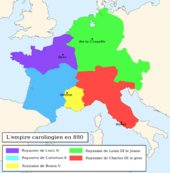Louis III of France
| Louis III | |
|---|---|
| King of West Francia | |
 | |
| Reign | 879–882 |
| Coronation | September 879 |
| Predecessor | Louis the Stammerer |
| Successor | Carloman II |
| Born | 863/865 St Denis |
| Died | 5 August 882 St Denis, Île-de-France, Neustria |
| Burial | Basilica of St Denis |
| Dynasty | Carolingian |
| Father | Louis the Stammerer |
| Mother | Ansgarde of Burgundy |
Louis III (863/65—5 August 882) was King of West Francia (a precursor to the Kingdom of France) from 879 until his death in 882. He succeeded his father and ruled over West Francia in tandem with his brother Carloman II. Louis controlled the northern part of West Francia (Neustria), including the capital of Paris, while Carloman controlled the southern portion (Aquitania). Louis ruled from March 880 to 5 August 882, when he died and left the rest of West Francia to his brother. His short reign was profoundly influenced by his military success, including his defeating of Northern Vikings in August 881.[1]
Early life[]
The eldest son of Louis the Stammerer and his first wife, Ansgarde of Burgundy,[2] Louis was born while his father was King of Aquitaine and his grandfather Charles the Bald was ruling West Francia. Some doubts were raised about his legitimacy, mostly due to the fact that his parents had married secretly and Ansgarde was later repudiated at Charles' insistence. Fortunately for Louis, he was a legitimate offspring and managed to prove it.
When Charles died in 877, followed by Louis the Stammerer on 10 April 879, some Frankish nobles advocated electing Louis as the sole king, but another party favoured each brother ruling a separate part of the kingdom. In September 879, Louis was crowned at Ferrières Abbey.[1]
Military success[]
On 2 February 880, Louis was defeated by the Viking Great Heathen Army at the Battle of Lüneburg Heath. But, in March 880 at Amiens, the brothers divided their father's kingdom, with Louis receiving the northern and western part, called Neustria. The other brother received the southern and eastern part, and Duke Boso, one of Charles the Bald's most trusted lieutenants, renounced his allegiance to both brothers and was elected King of Provence.

In the summer of 880, Carloman II and Louis III marched against him and captured Mâcon and the northern part of Boso's kingdom. They then proceeded to unite their forces with those of their cousin, Charles the Fat, then ruling East Francia and Kingdom of Italy, and unsuccessfully besieged the department of Vienne from August to November 880.
Still, however, Neustria was not very safe. Raiders had been invading Francia for several years. Louis' failed siege of Vienne led to further problems. However, this bad state of life was not to last long. In 881, Louis III achieved a momentous victory against Viking raiders, whose invasions had been ongoing since his grandfather's reign, at the Battle of Saucourt-en-Vimeu. The king and his victory were so acclaimed that within a year of the battle, an anonymous poet celebrated it and the king for both his prowess and piety in a short poem Ludwigslied, composed in Old High German. The king was very popular as a result of Ludwigslied and his victory.
Death and legacy[]
Louis III, at the time of his great successes, was very young, at a mere 16 to 17 years of age. His colourful victories against the Vikings entertained the public, and he was loved by most of the Francian people. In Neustria, he was widely celebrated, and he was the most popular person in the realm.
Whilst mounting his horse, Louis III died on 5 August 882, aged around 17, at Saint-Denis in the centre of his realm. He was chasing after a girl, who was retreating to her father's house, when he hit his head on the lintel of a low door and fell, fracturing his skull and killing him instantly.[3][4] Because Louis III had no children, his brother Carloman II became the sole king of West Francia, and the young king was buried in the royal mausoleum of the Basilica of Saint-Denis.[1]
Despite his short reign, Louis III was remembered greatly during his time for military prowess, but in modern times, he is widely forgotten. It is likely due to the fact that his reign was short and his accomplishments were relatively minor when considered with other military successes.
See also[]
- Charles VIII of France, another French king who died after hitting his head on a lintel.
- Carloman II, the successor of Louis III.
References[]
- ^ Jump up to: a b c "Louis III | king of France". Encyclopedia Britannica. Retrieved 23 March 2021.
- ^ McKitterick 1999, p. 258.
- ^ Le Bas, Philippe (1843). L'Univers, histoire et description de tous les peuples - Dictionnaire encyclopédique de la France. 10. p. 339.
- ^ Nelson, Janet (1994). Charles le Chauve. Aubier. ISBN 2700722612.
Sources[]
- McKitterick, Rosamond (1999). The Frankish Kingdoms under the Carolingians,. Pearson Education Limited.
- Green, Dennis H. "The Ludwigslied and the Battle of Saucourt", in Judith Jesch (ed.), The Scandinavians from the Vendel Period to the Tenth Century (Oxford: Boydell Press, 2002), 281–302.
- Fouracre, Paul. "The Context of the Old High German Ludwigslied", Medium Aevum, 46 (1985), 87–103.
- MacLean, Simon. Kingship and Politics in the Late Ninth Century: Charles the Fat and the end of the Carolingian Empire. Cambridge: Cambridge University Press, 2003.
- 9th-century kings of West Francia
- Frankish warriors
- 860s births
- 882 deaths
- Deaths by horse-riding accident in France
- Burials at the Basilica of Saint-Denis
- Carolingian dynasty
